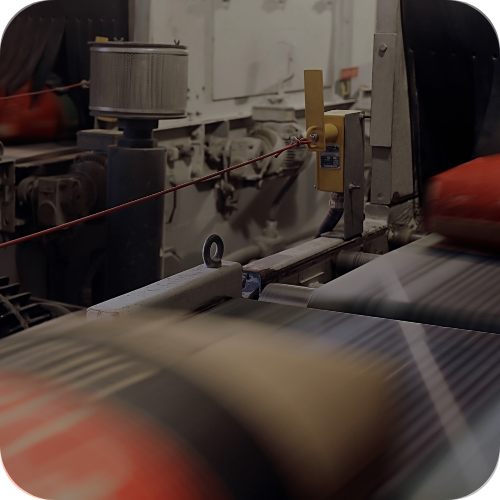Dx in Process Manufacturing
Industry Overview
In the face of rising global demand for raw materials, the metals, minerals, and cement industry faces the challenge of handling dynamic demand patterns while prioritizing environmental responsibility and cost reduction. Digital technologies become a key enabler to optimize processes intricately. AI algorithms analyze vast amounts of data to identify inefficiencies, predict equipment failures, and optimize production schedules, leading to reduced energy consumption, minimized waste, and increased resource efficiency. This fosters sustainable production practices while enhancing operational performances, profitability and ensures competitiveness in an ever-evolving market landscape.

Dx Opportunities
The convergence of digitization, vast data volumes, and large-scale operations presents an expansive opportunity. Despite the expanding potential, this sector faces disparity between digital aspirations and actual implementation impacting the digital effectiveness. Tridiagonal specialize at implementing these technologies at scale and helps can unlock the full potential of their operations, by driving efficiency, innovation, and environmental stewardship simultaneously.
Leverage predictive models to Improve the energy efficiency and AFR usage to reduce overall carbon footprint of the shop floor operations. Optimize the coal blend for providing optimal combustion to improve the reaction chemistry.
Use Cases: Blast furnace fuel consumption optimization, Aluminum smelter energy optimization, Sinter plant fuel consumption optimization, Air compressors energy management, Burning zone temperature prediction in rotary kilns
Energy Management
Metal mining and cement industries are one of the major sources of global emissions. Nature of the industry demands for high consumption of natural resources and fuels including coal, water, air and others. Management of GHG contributors across the processing facilities including utilities is key for improving the overall energy efficiency of the operations. For a production facility, it is important to operate at the optimal level to ensure that overall energy, steam, water consumption per unit production is minimum as per the predictions. Tridiagonal solutions tailored frameworks enables the organizations to have a deeper and meaningful insights about energy KPIs across the facilities. Thes solutions are curated to deliver the best-in-class solution to bring about the visibility of various energy sources and sinks using the hybrid approach leveraging first principles and data driven techniques.
.png?width=410&height=270&name=Slide%20In-1%20(2).png)
The optimization of energy in Heat Recovery Steam Generators (HRSGs) plays a crucial role in improving the efficiency and sustainability of combined cycle power plants. With AI based models operators can optimize the waste heat generated and correlate with the electricity produced. Operators can consume the prescriptions to plan the energy management across the facilities.
Electrical drives are one of the major energy consumers for these sectors. Tracking the energy of these drives through energy meters can help the manufacturers to plan and schedule the production ahead by 15-30 mins.
Industries have been seeing a big shift towards alternative fuels which include both solid and liquid wastes. Ensuring the same heat content is delivered by the AFR in comparison to traditional fuels is difficult to estimate. AI models can recommend the manufacturers with the required amount and combination of alternative fuels to meet the energy demand.
Track and monitor the steam, water and electricity consumption at equipment and site level operations. Predict the required amount of steam using first principles and benchmark it against the actual steam consumption. Track the overall steam economy across various unit operations and process across site, starting with Boilers to turbines and furnaces in processing facilities.
For more details on the use cases focusing on energy, steam, water and other resources please click here.
Improve the availability, maintainability of critical assets through the digital intervention. Improve the performance of ESP, Cylone separators, Kiln refractory lines and cement mills.
Uses Cases: Compressors performance prediction, Predictive maintenance of ball mills, bag house filters, roller press units. Channelling prediction in blast furnace operations
Predictive maintenance
Improve the performance and availability of ESP, Cylone separators, Kiln refractory lines and cement mills. Maintaining the availability for the desired period of uptime is one of the most important tasks for the production to run continuously to meet the market requirements. Critical assets spans from compressors, ESPs, separators and furnaces. Unforeseen operating conditions makes it difficult for the operators to understand the dynamics around the health of the equipment. Several factors including deviations in KPIs to seasonality variations lead to unplanned downtimes in the critical assets. With our expertise in dealing with rotating assets, it has been made possible to leverage the physics augmented data driven techniques to track the anomalies and deviations in the assets which can cause the chances of failures. With the predictions organizations can see multiple benefits in planning the maintenance activities to reducing the overall inventory costs.
.png?width=410&height=270&name=Slide%20In-2%20(2).png)
Air compressors are one of the most critical assets that ensure the production is met at their desired level of targets at minimum operating cost. Using this solution reliability team can predict the performance (Isentropic and polytropic) and health in real time. These modules help the team to predict the possibilities of failures with the deeper insights about the failure modes and prescriptions.
ESPs are essential in the metal industry for removing particulate matter from exhaust gases before they are released into the atmosphere. AI enabled predictive maintenance models can provide early indicators for anomalies in the ESPs which may result in unplanned downtimes leading to unwanted stoppages in the production
Predict the failures of bearing due to excessive vibrations leading to unplanned downtimes. AI models provides early indicators with the information of the critical components and the contributors dictating the failure modes.
Ball mills, crucial for grinding raw materials and clinker in cement production, demand high reliability and optimal performance to maintain continuous production. AI models enables the operators with the early signatures providing insights about the critical deviating parameters to prevent any bearing, misalignment or lubrication related issues.
Using non-linear inferential for predicting the feed, fuel and product quality in real time. Prediction of hot metal ferro-alloy composition in the secondary steel making to prediction of clinker and residue quality in cement manufacturing operations.
Use Cases: Inferential for prediction of clinker quality, Fuel / AFR %sulfur prediction, Blaine prediction in cement mills, Internal crack prediction in cast house for metals
AI based inferentials
Quality management for various entities including feedstocks to fuels and product is important to produce with satisfactory level of quality standards. Most of quality variables are recorded based on the lab sampling at certain low frequent intervals, which makes it difficult for the control room operators to take the real time corrective actions. With inferential modeling process operators can gain deeper insights about the set point control changes required for achieving the optimal quality specifications. Physics driven inferentials can enable with real time prediction of quality variables for critical assets.
.png?width=410&height=270&name=Slide%20In-3%20(2).png)
AI models to predict the % silica content in the iron ore concentrate to improve the process in real time in froth floatation process. With early process corrections, excess energy consumption can be minimized to achieve the desired quality
Predict the Silicon content in hot metal during blast furnace operations to assess the thermal operating condition. Maintaining silicon content within the desired specifications enables to achieve thermal stability with increase in furnace productivity
Prediction of pitch demand and anode density to achieve superior quality of anode for aluminum manufacturing. Prediction enables the manufacturers to improve the reliability of the overall smelter operations.
Maximizing the production throughput with desired quality specifications in the blast furnace operations and secondary steel making. Enhancing the production of clinker in rotary kiln operations with desired hardness specifications.
Use Cases: Optimization of %return fines on blast furnace, Improving the productivity of blast furnace operations, burning zone temperature prediction in rotary kiln, Improving the throughput of cement mill operations.
Process optimization
Maintaining the product grade as per the desired quality specification and minimum energy consumption is important to reduce the overall cost of manufacturing. Minimize the grade transition period and product off-specifications through AI based prescriptive analytics. Operate at the maximum possible efficiency with optimal cycle time of heat in order to improve continuously. Optimize the cycle time of the processes through AI-based optimization toolbox. Leverage the AI based simulators to continuously identify the opportunities to optimize the control strategy to meet the desired product specifications at minimum operating costs.
.png?width=410&height=270&name=Slide%20In-4%20(2).png)
AI model can help to determine the optimal addition of Flux materials to eliminate the impurities generated during the production of Liquid Steel. AI models prescribe the manufacturers to optimize the addition of the external additives to reduce the overall cost of production and ensure product specifications are met during each heat.
Sequential AI models can predict the optimal level of ALF3 required to maintain the bath temperature and excess ALF within the specifications. This model can help the operators to minimize the energy consumption and maintain the quality requirements of the hot liquid aluminum from the smelters.
Rotary kiln operations are critical to remain stable under the varied conditions of fuel, feed and seasonality fluctuations. AI based models can correlate the impact of these factors with the burning zone temperature. Prescriptions can help to maintain the BZT under several fluctuating influences
Leverage the zero shot and few shots LLMs to interpret and analyze the unstructured dimensions. Integrate the interpretation from quality reports, product compliance report, incident reports and many others for improving the productivity and gaining deeper insights about the operational dynamics.
Uses Cases: Alarm report analytics, RCA/Incident reports correlation with real time process anomalies, conversational AI for real-time production information.
Generative AI
More than a quarter of data remains unused as it becomes difficult to access and interpret them due to its unstructured and non-standard formats. Documentation spans from raw materials information, production reports to quality and compliance records. Generative AI can be leveraged to automate the interpretation of the information using the zero shot and few shots LLMs to interpret and analyze the unstructured dimensions. Integrate the interpretation from quality reports, product compliance report, incident reports and many others for improving the productivity and gaining deeper insights about the operational dynamics.
.png?width=410&height=270&name=Slide%20In-5%20(1).png)
In order to continuously improve the shop floor productivity, it is important to extract many unstructured information such as visual and physical characteristics of the product. Usually, such information are available in siloed unstructured documents. LLM models can be leveraged to extract and derive meaningful insights from these documents to provide the intelligence to the operations team
Alarms are critical to be monitored and categorized in several priorities. With the LLMs unstructured alarm reports can be segregated based on its criticality and frequency. These models can augment advanced analysis intelligence to estimate and correlate the information with process parameters
Improve the interpretability with meaningful insights derived from the historical RCA reports. Real time anomalies can be correlated with the historically similar events with the added intelligence about the indicators and corrective actions.
An Operator Training Simulator (OTS) is a high fidelity, computer based system that enhances operator skills, safety, and efficiency in complex industrial environments by providing a realistic, risk-free training environment. It ensures operators are well-prepared for both routine and emergency situations, contributing significantly to the overall success and safety of the organization.
Use Cases: Realistic Training Environments, Risk Free Simulations, Scenario-Based Learning, Performance Tracking, Knowledge Retention, Regulatory Compliance are the highlights of OTS.
Operator Training Simulator (OTS)
In the intricate and high-stakes world of industrial operations, ensuring the skill and readiness of operators is essential. An Operator Training Simulator (OTS) is a crucial tool in this realm, offering numerous benefits that enhance safety, efficiency, and overall operational success. Key advantages of an OTS is its ability to provide a realistic yet risk-free training environment. Operators can engage with simulations of actual industrial systems, practicing routine tasks and responding to emergency situations. This hands-on experience is vital for developing the skills needed to handle real-world operations confidently. By simulating hazardous scenarios, operators learn to manage potential crises without endangering personnel, equipment, or the environment.
.png?width=410&height=270&name=Slide%20In-5%20(1).png)
An OTS provides comprehensive scenario-based training, encompassing normal operations, startups, shutdowns, and emergency responses. This diverse array of training scenarios ensures operators are well-prepared for any situation they may face. The opportunity to repeatedly practice these scenarios helps ingrained proper procedures and quick decision-making skills, significantly reducing the likelihood of errors during actual operations.
A key feature of an OTS is its ability to continuously track and evaluate operator performance. By providing detailed feedback and pinpointing areas for improvement, it fosters a culture of continuous learning and development. This ongoing assessment ensures operators maintain high proficiency levels and can effectively adapt to new challenges.
Safety is paramount in industrial operations, and an OTS significantly raises safety standards. Well-trained operators are less prone to errors that could result in accidents, thereby safeguarding both personnel and equipment. Additionally, by minimizing operational mistakes and unplanned downtime, an OTS enhances overall efficiency, leading to more streamlined and productive operations.
Implementing an OTS is financially advantageous, as it reduces errors and downtime, leading to substantial cost savings. Additionally, an OTS ensures that operators receive consistent and comprehensive training, aiding organizations in meeting industry regulations and standards. This thorough training can be documented and audited, facilitating compliance.
Training operators on the following:
- Kiln Operation: Train on the startup, shutdown, and control of rotary kilns for clinker production.
- Raw Mill Operation: Simulate the grinding and mixing of raw materials for consistent feed to the kiln.
- Clinker Cooler Management: Train operators on optimizing the cooling process and maintaining equipment.
- Cement Mill Optimization: Provide training on the operation and maintenance of cement grinding mills.
- Safety and Emergency Response: Simulate safety protocols and emergency scenarios for hazardous situations.
- Maintenance Planning: Train on predictive and preventive maintenance techniques for plant equipment.
- Blast Furnace Operation: Simulate the startup, shutdown, and control of blast furnaces for iron production.
- Electric Arc Furnace (EAF) Management: Train operators on the operation and optimization of EAFs for steelmaking.
- Continuous Casting: Provide training on the continuous casting process to produce high-quality metal slabs.
Use Cases
In the realm of metals, mining, and cement, digital innovations persist as catalysts, helping these energy intensive industries to optimise their process and improve resources allocation in their quest of sustainable production. Below is the list of use cases specific to given that resonates with the actual challenges faced by in mineral processing industry.
Accelerate your Dx transformation projects with Smart Apps and Time-to-value (TTV) program
Integrate ready-to-deploy smart apps with your existing IT-OT infrastructure and scale across plants.







- Smart Apps
- TTV A-33 Program
Tridiagonal Solutions launches ‘Process optimization framework’ for manufacturing industry. We optimize processes for energy, efficiency, quality using cutting-edge technology and engineering expertise. From custom column design to process intensification, we're driving innovation for a sustainable future.
Leveraging these frameworks allows the industry to implement the ML models at scale.
Time to Value program leverages advanced scalability frameworks to deliver superior analytics solutions to manufacturing industries. Designed for rapid implementation, our program ensures larger delivery with unparalleled speed and efficiency. By utilizing scalability frameworks, we significantly reduce the time and cost associated for standard approaches. and accelerates deployment, allowing manufacturers to quickly gain insights and drive improvements in their operations. With our program, clients benefit from faster, data-driven decision-making, enhanced productivity, and a swift return on investment, making it the optimal choice for modern manufacturing analytics projects.
Why Tridiagonal?
Team having exposure and expertise of developing scalable solutions across multiple platforms.
Looking for Trusted Partner for executing your programs?
We bring together unparalleled expertise with combination of skillsets and technology to address your digital, computational and testing needs

.png)





